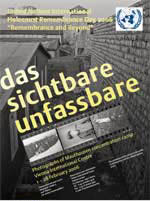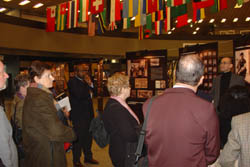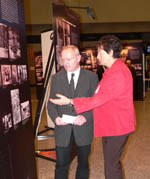 Anneliese Heber and Konrad Eckl of UNIS Vienna, in collaboration with the Austrian Federal Ministry of Internal Affairs, organized the opening of a photo exhibition titled "Das Sichtbare Unfassbare" ("The Visible, yet Incomprehensible") at the Vienna International Centre (VIC) today. The exhibition which features 450 black and white images of the Nazi death camp Mauthausen, Austria, marks the first United Nations International Day of Commemoration in memory of the victims of the Holocaust, observed on 27 January. The exhibition was inaugurated in the VIC Rotunda by Austrian Federal Minister for Internal Affairs, Liese Prokop, in the presence of H.E. Ambassador Israel Michaeli, Head of the Permanent Mission of Israel to the IAEA and CTBTO, and senior officials of the Austrian Government.
Anneliese Heber and Konrad Eckl of UNIS Vienna, in collaboration with the Austrian Federal Ministry of Internal Affairs, organized the opening of a photo exhibition titled "Das Sichtbare Unfassbare" ("The Visible, yet Incomprehensible") at the Vienna International Centre (VIC) today. The exhibition which features 450 black and white images of the Nazi death camp Mauthausen, Austria, marks the first United Nations International Day of Commemoration in memory of the victims of the Holocaust, observed on 27 January. The exhibition was inaugurated in the VIC Rotunda by Austrian Federal Minister for Internal Affairs, Liese Prokop, in the presence of H.E. Ambassador Israel Michaeli, Head of the Permanent Mission of Israel to the IAEA and CTBTO, and senior officials of the Austrian Government.
 After opening remarks by Christian Strohmann, OiC UNIS, the video-message by the United Nations Secretary-General Kofi Annan on the occasion of the first holocaust remembrance day was played. In his message, the Secretary-General emphasized that "the United Nations was founded as a reaction to the horrors of the Second World War. Even so, the international community has too often failed to stand up to mass atrocities. On this International Day of Commemoration, the theme of our observance is "remembrance and beyond". In that spirit, let us pledge ourselves to even greater efforts to prevent genocide and crimes against humanity". The message was also read out in German by Anneliese Heber of UNIS Vienna.
After opening remarks by Christian Strohmann, OiC UNIS, the video-message by the United Nations Secretary-General Kofi Annan on the occasion of the first holocaust remembrance day was played. In his message, the Secretary-General emphasized that "the United Nations was founded as a reaction to the horrors of the Second World War. Even so, the international community has too often failed to stand up to mass atrocities. On this International Day of Commemoration, the theme of our observance is "remembrance and beyond". In that spirit, let us pledge ourselves to even greater efforts to prevent genocide and crimes against humanity". The message was also read out in German by Anneliese Heber of UNIS Vienna.
 "It is taken for granted by many Europeans nowadays that they live in a democracy," said Austrian Federal Minister for Internal Affairs, Liese Prokop. "As a result, it is sometimes suggested to let the past lie. Should one not forget the horrors of the past and concentrate on the present? The answer is given to us by the survivors, warning us to be vigilant and take the lessons of the past seriously. It is our duty to spread the knowledge about the atrocities in the concentration camps and the horrors of the Nazi dictatorship, to consult the witnesses, and to support research, which has not yet answered all questions on the Nazi regime." The Minister expressed her pleasure over the fact that the exhibition was being displayed at the VIC and also expressed her hope for further collaboration between her Ministry and the United Nations on important themes such as the prevention of hatred and violence.
"It is taken for granted by many Europeans nowadays that they live in a democracy," said Austrian Federal Minister for Internal Affairs, Liese Prokop. "As a result, it is sometimes suggested to let the past lie. Should one not forget the horrors of the past and concentrate on the present? The answer is given to us by the survivors, warning us to be vigilant and take the lessons of the past seriously. It is our duty to spread the knowledge about the atrocities in the concentration camps and the horrors of the Nazi dictatorship, to consult the witnesses, and to support research, which has not yet answered all questions on the Nazi regime." The Minister expressed her pleasure over the fact that the exhibition was being displayed at the VIC and also expressed her hope for further collaboration between her Ministry and the United Nations on important themes such as the prevention of hatred and violence.
The launch of this Holocaust exhibition was attended by about 150 representatives of permanent missions to the UN in Vienna, NGO activists, visiting high school students groups, and staff of Vienna based international organizations. After the opening ceremony, Mr. Stephan Matyus, Representative of Mauthausen Memorial Archives, guided the audience through the exhibition. The event also generated considerable media attention.
Approximately 200,000 persons from all over Europe were imprisoned, tortured and forced into heavy labour between 1938 and 1945 in the Nazi concentration camp Mauthausen, Austria, and its satellite camps. Almost half of them were killed. The photographs of the exhibit document different aspects of the concentration camp system, its liberation and the time thereafter. Many of these visual testimonials are on display for the first time -- the reason being that after the end of the War, the photos were dispersed all over the world. The exhibition was compiled by the Austrian Federal Ministry for Internal Affairs and can be viewed as part of a guided tour of the VIC until 24 February.